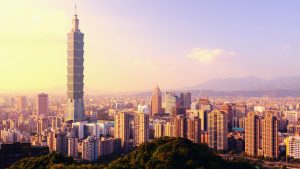April 3 began as a typical day for the people of Taiwan. Workers and students set out on their usual commutes as cities across the island bustled with the usual activities of daily life. At 7:58 a.m. local time, during the peak of morning rush hour, a 7.4-magnitude earthquake struck off the east coast of Taiwan, marking the most significant seismic event in nearly 25 years.
To put the size of this earthquake into context, a magnitude 7 earthquake has been described by seismologists as having the “energy equivalent to around 32 Hiroshima atomic bombs.” Taiwan’s 921 Earthquake, named after the date it took place on September 21, 1999, was 7.7 in magnitude and left more than 2,400 people dead and around 11,300 injured.
Nearly a quarter century later, Taiwan has made substantial progress in minimizing casualties and damages brought upon by earthquakes. Following the earthquake last Wednesday, 13 deaths have been confirmed, with thousands injured. Media outlets across the world have highlighted the remarkably low numbers in praise of Taiwan’s preparedness against earthquakes.
Taiwan’s decades of experience in building resilience against earthquakes into its regulations, structures, and society shielded its nearly 24 million residents from the worst effects of catastrophe. It also offers a realistic view of what building resilience against a catastrophic conflict with neighboring China would require from the nation.
In 1999, Taiwan’s devastating 921 Earthquake resulted in more than 100,000 buildings collapsing completely or partially, contributing significantly to casualties. The legislature has since amended building codes such as the “Design Specifications for Concrete Structures,” which regulates rebar reinforcement methods that strengthen concrete columns found in most buildings, as well as the “Seismic Design Specifications and Commentary of Buildings,” which enforces the evaluation of location-specific factors including proximity to fault zones in determining seismic safety requirements.
Taiwan’s enforcement of strict regulations has necessitated resilience to be literally built into its structures to withstand future disasters. Far from a one-and-done process, these safety codes have been kept up to date to incorporate the use of technological innovation in evaluating seismic safety and retrofitting aged structures. The damages reported from the April 3 quake – 18 buildings with major structural damage, 34 with non-major structural damage, and 194 with minor damages – underscore the impact of substantive policymaking.
Structural resilience is only one facet of Taiwan’s strategy. On April 3, a calm and collected citizenry adhered to practiced evacuation protocols to seek safety. Critical infrastructure systems such as water and electricity operated through disruptions, and businesses, including those in key sectors such as chipmaking, followed best practices to ensure rapid recovery.
The degree of social resilience displayed on April 3 was not only a result of routine safety drills mandated by government regulations but also stemmed from the public’s continued exposure to the real and recurring threat of earthquakes in Taiwan: Its people experience a thousand earthquakes per year that are strong enough to be felt.
A whole-of-nation approach to resilience, driven by recurring threats and built directly into Taiwan’s structures and society, would seem applicable to a conflict scenario with China, which claims the self-ruled island as part of its territory.
A 2023 wargame report by the Center for Strategic and International Studies (CSIS) in Washington, D.C., projected that a Chinese invasion of Taiwan could result in a devastated economy, crippled infrastructure, and massive military and civilian casualties. The threat of aggression from China is also perpetuated by the daily incursions into Taiwan’s Air Defense Identification Zone (ADIZ), economic coercion, cyberattacks, and other gray-zone warfare tactics that have both tangible and psychological effects on the people of Taiwan.
As such, the imperative to bolster the resilience of “structures” such as Taiwan’s military, economy, diplomacy, cybersecurity, information, and society should be clear. Policymaking to that end, however, has often been impeded by political divisions and differing approaches to cross-strait relations.
In February 2023, a proposed amendment to the “All-out Defense Mobilization Readiness Act,” aimed to enhance information resilience in preparation for war, was met with criticism over potential curbs on press freedom and political dissent. Under immense public pressure, the draft was ultimately withdrawn, and the debate on how to build wartime information resilience has since fizzled out altogether.
Similarly, Taiwan’s decision to re-extend compulsory military service to one year starting in 2024 has afforded its military greater resilience. However, the proposal initially faced political and public pushback, highlighting a lack of consensus on what is required to best prepare the nation against the threat from China.
Society has picked up the work of resilience-building in areas where legislation has been lacking. Non-governmental organizations including Kuma Academy and Forward Alliance are civil defense groups that offer first aid skills and evacuation training, while other groups such as the Taiwan FactCheck Foundation and Cofacts work to promote reliable information, digital literacy, and defend Taiwan’s information ecology against China.
Societal resilience and public awareness against China’s aggression can develop even without policy as a driving force, but resilience in key elements of Taiwan’s national security, such as its military, economy, and infrastructure, requires a top-down approach regulated by comprehensive policy. Furthermore, legislation must remain current to tackle ever-emerging challenges and harness innovation to optimize the use of limited resources.
With Taiwan’s legislature divided, any policy endeavor would necessitate earnest collaboration among the political parties to forge consensus. This may be challenging but not unprecedented.
The people of Taiwan have a history of enduring and recovering from adversity, both natural and human. Last week, they demonstrated once again the nation’s unwavering unity. The Chinese Communist Party is no force of nature. Taiwan has fortified its resilience in the wake of earth-shattering events – it must do the same in the face of the threat from China.

































